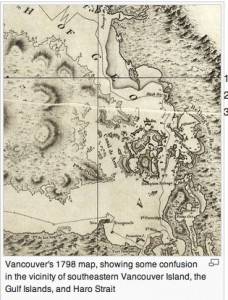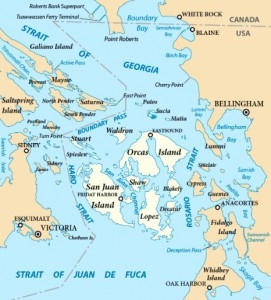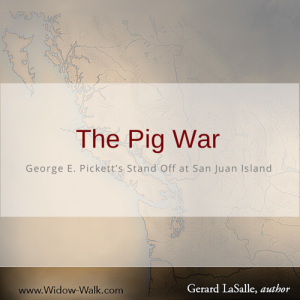The Pig War
Oregon Country: A Brief History of a Land Shared by the US and Britain

Image Source: http://hdl.loc.gov/loc.gmd/g3512c.ct000914
- Widow Walk is a work of historical fiction based on true events that occurred between the years 1852 to 1859 in the Pacific Northwest, then called the Washington Territory of the “Oregon Country.”
- One of the central pieces of history in Widow Walk is the dispute between the US and Britain and division of the land that made up the Oregon Country which is in the present day Washington, Oregon, Idaho, British Columbia and parts of Montana and Wyoming
- The two nations had jointly occupied Oregon Country since 1818
- A resolution was proposed via “The Oregon Treaty” signed in 1846
- The treaty was negotiated by US Secretary of State and future U.S. president James Buchanan and the British envoy to the US, Richard Pakenham
- Treaty established the US and British border at the 49th parallel, with the exception of Vancouver Island, which was retained entirely by the British
- The treaty was written by policy makers in London. Unfortunately, it failed to specify which strait (Rosario or Haro) made up one part of the borders. This ambiguity forced into question which government governed the San Juan Islands, which included San Juan, Orcas, Blakely, Shaw, Decatur, Lopez, Stuart and Waldron Islands.

Image Source: Wikimedia.Org
- Both Britain and the US wanted control of the San Juan Islands and ultimately a standoff took place on San Juan.
 Pig War: George E. Pickett’s Stand Off at San Juan Island
Pig War: George E. Pickett’s Stand Off at San Juan Island
- In Widow Walk, Captain George E. Pickett leads a standoff between his small company of men and three British naval ships that had been dispatched from Esquimalt, B.C.
- Both Britain and the US wanted control of the San Juan Islands which represented significant strategic value to control of the Strait of Juan de Fuca and Puget Sound.
- Both countries employed tactics to claim sovereignty as a means “to protect its citizens”. The British Hudson Bay Company established a sheep farm on San Juan Island. Washington Territory North Puget Sound’s tax agent Isaac Ebey (the historical figure upon whom is based our Isaac Evers in Widow Walk), urged the Olympia territorial government to subsidize settlement of San Juan Island by U.S. citizens.
- The gold rush brought many American settlers to the area and some made their way to the San Juan Islands
- One settler shot a pig owned by a Hudson Bay Company official when settler found the pig rooting in his garden. The pig’s owner refused payment by the settler, stating that the animal was his “pet”, and demanded that the U.S. settler be placed in irons and taken to Victoria for trial in the British court.
- This incident led to a great deal of unrest between the American and British citizens on the island
- General William S. Harney, the Oregon Country’s commandant, ordered Captain George Pickett to bring his company of men from his Bellingham garrison to the island to protect the rights of the American citizens
- Meanwhile paid magistrate of Britain came armed to the islands and demanded that Pickett and his men leave or face trespassing charges
- Pickett refused. He dug in his heels and the stand off, now known as the “Pig War“, attracted national attention.
- Pickett was quoted as having said “Let them come. We’ll make another bloody Bunker Hill of it.”
- Three British naval ships arrived and practiced gun drills too close to Pickett’s camp for his comfort; he moved camp but still refused to leave the island
- General Winfield Scott, sent from Washington D.C. by President James Buchanan to represent the U.S. Scott traveled westward across the isthmus of New Grenada (present day Panama).
- Neither side wanted the matter to escalate so the peaceful standoff continued, even after Pickett and many other regional officers resigned their U.S. military commissions and left to join the Confederate Army.
- With the beginning of the Civil War, resolution of the matter was delayed. A compromise was worked out and both sides agreed to establish camps on San Juan Island until a new treaty could be established.
- Kaiser Wilhelm I of Imperial Germany finally settled the matter of ownership in November 1872.